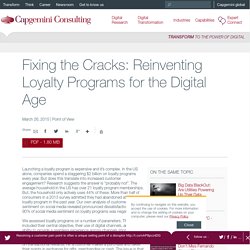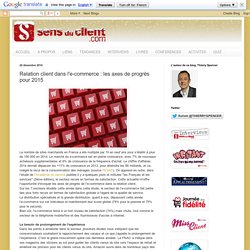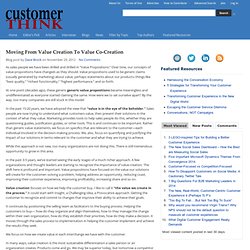

Comment prendre de bonnes décisions, Directions générales. Accueil Olivier Sibony, auteur de « Réapprendre à décider », propose des antidotes aux biais - ou raccourcis pris par le cerveau - qui amènent à commettre des erreurs dans la conduite des affaires.(...)

Cet article est réservé aux abonnés, pour en profiter abonnez-vous. Et aussi sur les Echos. Darty renforce son service clients en livrant... Le drive et le click and collect ?

Bien, mais visiblement pas suffisant à l’heure où le service clients, plus que jamais, fait la différence. Doit faire la différence, plutôt… C’est ainsi que Darty annonce vouloir raccourcir ses délais de livraison et de dépannage à domicile pour ses clients. Mais la livraison, d’abord. A compter de ce 30 mars 2015, Darty met en place un service « J-0 » (bien lire : zéro) sur le gros électroménager et la télévision. Fixing the Cracks: Reinventing Loyalty Programs for the Digital Age. Launching a loyalty program is expensive and it’s complex.

In the US alone, companies spend a staggering $2 billion on loyalty programs every year. But does this translate into increased customer engagement? Service à la personne : le secteur mute peu à peu sur Internet, Actualité des PME. Les plates-formes de mise en relation entre prestataires de services et particuliers se multiplient.

Jusqu’ici peu présents sur Internet, les services à la personne vivent une véritable révolution. En quelques mois, plusieurs sites Internet se sont créés sur le même créneau, mettant en relation particuliers et prestataires de services et court-circuitant les agences traditionnelles. A tel point que le secteur attire les plus grands noms : Google a investi aux Etats-Unis dans Homejoy, une plate-forme pour trouver une aide ménagère, Amazon vient de lancer Amazon Home Services pour trouver un jardinier, un plombier ou un électricien. En France, quelques « serial entrepreneurs » se sont positionnés, tel Denys Chalumeau, fondateur de Seloger, qui a créé SeFaireAider , une société qui a récemment ouvert son capital à TF1, ou Marc Simoncini (Meetic) qui a misé sur FamiHero , une plate-forme pour trouver baby-sitter, soutien scolaire ou aide à domicile.
Economie parallèle Nicolas Rauline. RETAIL : CROSS CANAL, MAGASIN DU FUTUR, MERCHANDISING. Relation client dans l'e-commerce : les axes de progrès pour 2015. Le nombre de sites marchands en France a été multiplié par 10 en neuf ans pour s'établir à plus de 150.000 en 2014.

Le marché du e-commerce est en pleine croissance, avec 7% de nouveaux acheteurs supplémentaires et 9% de croissance de la fréquence d'achat. Le chiffre d'affaires 2014 devrait dépasser les +11% de croissance vs 2013, pour atteindre les 56 milliards, et ce, malgré le recul de la consommation des ménages (source FEVAD). On apprend en outre, dans l'étude de l'Académie du service publiée il y a quelques jours et intitulée "les Français et les services" (2ème édition), le secteur recule en termes de satisfaction. L’Expérience client sera "LE&... Amazon veut livrer lui-même ses produits. Moving From Value Creation To Value Co-Creation. As sales people we have been drilled and drilled in “Value Propositions.”

Over time, our concepts of value propositions have changed–as they should. Value propositions used to be generic claims (usually generated by marketing) about value, perhaps statements about our products–things like “best quality,” “richest functionality,” “highest performance.” and so forth. At one point (decades ago), these generic generic value propositions became meaningless and undifferentiated as everyone started claiming the same. How were we to set ourselve apart? By the way, too many companies are still stuck in this mode! Successful Sales Management: Reengineering Sales Management. A manifesto for modern sales management – embracing the new order of customer driven buyer/seller relationships.

In today’s flatter, faster world, prospects are smarter and better informed. They’re suspicious of claims made by sellers, more demanding of personalised offers, insistent on controlling the relationship. Vendors must know what will make the customer happy, prove how they’ll deliver it, and do it at a price which can be paid. Sales managers need to evolve from lion tamers into engineers, with resources, strategies and processes which can be continuously improved. Sales people need to evolve from robotic drones into intelligent capable entrepreneurs – business people who can develop value adding and sharing relationships with customers.
CRM Is Yesterday's Answer To The Wrong Problem. Why doesn’t CRM work?

Because its an answer to the wrong problem. Another heretical thought from the people who suggest sales managers need to change just about everything. Why People Buy and How They Perceive Value. Some time ago, I wrote a blog post about the elusive nature of "value.

" The post told the true story of a man who started with a red paperclip and, through a series of improbable bartering trades, ended up in possession of a house. I was reminded of this story when a recent episode of the NBC television show "The Office" explored a similar theme—at a company garage sale Dwight begins with a trivial item and keeps “trading up” until at last he's attained a telescope (which in predictable sitcom fashion then gets traded for a packet of magic legumes).
It's the eternal question for advertisers, marketers, developers, sales professionals and customer service strategists: Why do people buy and how do they perceive value? The Importance of Customer Support. Customer support used to be an afterthought.

Now, support has become a standard component of the product package, and is an area in which companies can, and do, distinguish themselves from their competition. With customer experience management bookmarked on every C-Level’s laptop, all service and support channels are being scrutinized for improvement opportunities. Providing consistent, superior customer support experiences is an optimal way to increase customer loyalty — and increase revenue. 3 Reasons You Should Improve Your Customer Support. Upselling and Cross-selling by Customer Service and Support Teams. As the economy recovers, many companies are looking for opportunities to claw their way back to pre-recession sales levels.
And companies that fared well want to be sure to keep their customers as competition in the playing field grows. Add a Touch of Service to Your Sales. Service-orientated selling is a proven approach to providing a world-class customer experience. Using high-pressured sales tactics may result in short term success to meet a quarterly goal, but to sustain long-term company success, customer relationships must be fostered.
Call Center Best Practices. Call centers that handle service and support calls are, unfortunately, often viewed as cost centers. Although these centers usually don’t bring in revenue directly, they do contribute to the company’s goals in many valuable ways, most notably in reinforcing the company’s brand and in increasing customer loyalty. To raise the visibility of your call center as a valuable contributor to your company’s growth and bottom line profits, follow these six best practices. Know Where You’re Going. Best Practices for Email Customer Service. Email is often the preferred service and support channel for customers. There are two things customer service representatives should do to guarantee world-class email customer service. 1.
Question Strategically. Live Chat Best Practices. No matter which service or support channel a customer chooses – the customer experience must be positive. A growing number of customers are opting for web chat when needing to communicate with a company. Web chat has many benefits for the customer including the ability to multi-task, which is a welcome advantage for people with busy schedules. However, the customer’s experience can be less than favorable if the live chat agent uses too many scripted lines, fails to personalize comments, or asks questions irrelevant to the customer’s need. While many service and support agents will transition naturally into a live chat role, some may need chat etiquette training to improve their written communication skills.
How to Provide Customer Service Through Live Chat. Best Practices for Improving Supervisory Skills. Perception and Customer Service. Think about the last time you experienced truly great customer service. What made it so memorable? The case of Customer complaints. Oracle Survey Finds Customer Experience Divide. Feb 6 2013 | Resource: Daily News By: Phillip Britt, Loyalty 360 Back To Results A just-released study by Oracle, Redwood Shores, Calif., finds a large disconnect between the customer experience aspirations of firms and their actual practices. More than nine in 10 companies (91 percent) say that they want to be a customer experience (CX) leader, but more than a third (37 percent) of firms are just getting started with a formal CX initiative. Only 20 percent of those surveyed said that they considered their CX initiative to be “advanced.” Customer Experience vs. Compensation: a Customer Service Showdown. The other night, I went to dinner at one of my new favorite restaurants.
When I sat down, I couldn’t help but notice the table next to me was not having a pleasant dining experience. The two diners’ body language said it all. They both had their arms folded and were clearly trying to get the waiter’s attention by staring and gesturing for him to come over to the table. He apologized several times for something I could not decipher.
Loyalty: The Currency of Customer Satisfaction – Part 1. Check out any online community that deals with customer service (and believe me, I’ve checked out my share) and before long you’ll find a posting on “loyalty.” The topics are varied: “Loyalty and Customer Satisfaction;” “Does quality service always equal loyalty?” Etc. The desire to understand loyalty is simple: customer loyalty is the “currency” we use to measure our customers’ satisfaction. What are some of the major factors that impact customer loyalty? Exclusivity (“obligatory loyalty”): If a company produces a unique product or is the only service provider in a certain area, the loyalty of their customers is obligatory. Example: Aside from file servers, most of us who use computers in our daily work routines are running those computers on operating systems from one of two major companies. Loyalty: The Currency of Customer Satisfaction – Part 2.
The Role of Consistency in Professional Support – Part 1: Employee Coaching. The Role of Consistency in Professional Support – Part 3: Communication Skills. Customer Service and Support Trends 2012. Leading companies will monitor their customers, not just their agents.Small & medium sized businesses will crowd-source customer service and support.Successful companies will focus on providing proactive support.Service will be geared to customer personality types.Investing in front-line supervisors will be the mark of success.Customer service agents will do more up-selling and cross-selling.Service and support will be tailored for mobile devices.Contact centers will track customer-focused metrics.Social media will be integrated into service and support.Managers will focus on improving the employee experience.
Monitor Your Customers, Not Just Your Agents. Companies are reframing customer service as a strategic method for gathering important information to inform marketing direction and product development. While you can obtain valuable insights by monitoring your social media channels, adding insights from your call center will provide a greater breadth and depth of information. The Employee Experience: Motivate, Empower, Invest. There’s a concern brewing in employers everywhere. If the economy keeps moving in a positive direction, employees may take their talent elsewhere. Human factor in service design.pdf.
Using Social Media for Service and Support. Is There an App for That? Tailoring Customer Service for Mobile Devices. The Difference Between Customer Service and Customer Experience. The Ultimate Customer Experience. Social Customer Service Battleground. Customer Experience Management: The Role of a Chief Customer Officer.
4 Tips for Building a Thriving Self-Serve Community for Customer Service. Lagardère Services s’associe avec Relais. "Marketing Funnel. Bringing the voice of the customer into the factory.